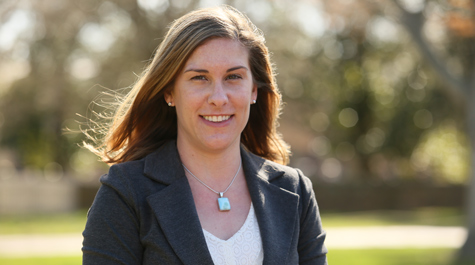At the Graduate Research Symposium: Tracing lifestyle changes in 19th century Hawaiian homes
“Captain Cook arrived in Hawaii in 1778 and other European/American people followed,” she explained. “The early 19th century was a dynamic period of social change. Even as outsiders were beginning to arrive in Hawaii, the island chain was being politically united from within.”
Moore is a Ph.D. student in William & Mary’s Department of Anthropology. Her research for her dissertation on the changing domestic economy of Hawaiian households won her numerous honors. In addition to a Doctoral Dissertation Improvement Grant from the National Science Foundation, she also is a recipient of one of two $2,000 William & Mary Interdisciplinary Awards for Excellence in Research. Moore’s second honor will be presented at the 16th Annual Graduate Research Symposium March 24-25 at William & Mary’s Sadler Center.
The Nā Pali Coast, site of Moore’s research, is a remote wilderness area on the Hawaiian Island of Kaua‘i.
“Today you can only get there by aircraft or boat,” she said. “Two hundred years ago, you went by canoe.”
Her project was conducted in collaboration with Hawai‘i State Parks, an organization that Moore said often works closely with the local Hawaiian community. She said the Nā Pali Coast ‘Ohana, a cultural stewardship and heritage preservation group, was particularly involved in her project.
 Most anthropologists working in Hawaii, including Moore’s advisor, Associate Professor Jennifer Kahn, focus on understanding what pre-Cook life was like on the islands. Moore is looking at a later period, excavating and analyzing two neighboring 19th-century house sites in what now is a state park. Moore believes the home sites reveal a great deal about how natives of the islands adopted elements of the new culture brought by sailors, planters and missionaries.
Most anthropologists working in Hawaii, including Moore’s advisor, Associate Professor Jennifer Kahn, focus on understanding what pre-Cook life was like on the islands. Moore is looking at a later period, excavating and analyzing two neighboring 19th-century house sites in what now is a state park. Moore believes the home sites reveal a great deal about how natives of the islands adopted elements of the new culture brought by sailors, planters and missionaries.
Pre-contact domestic life in the islands centered around the kauhale, a cluster of small structures that was home to a family of a dozen or more people.
“Some of the family relationships were different than what we think of as our nuclear family today,” Moore explained. “It was more of an extended-family model. You would have a fairly large group of people who would decide to form a social group — it’s an economic group as well.”
As people from the mainland began populating the islands, the Hawaiians began evaluating the lifestyles of the newcomers. Hawaiian women began incorporating items they saw being worn by missionary women into their dress, for example, although Moore says in the early 19th century the Hawaiians often seemed to regard the introduced garments more as accessories than as clothing.
The European-American influx had an even greater change on home life. Moore explained that many scholars argue that these changes began with the dissolving of the kapu. This set of religio-social requirements governed Hawaiian daily life. She explained that the multiple-building makeup of the kauhale was in large part dictated by the requirements of the kapu that separated people and activities.
“Once the kapu is broken, there’s no longer an official requirement to separate out cooking space from sleeping space or to keep men’s and women’s eating spaces apart.”
The 19th century saw increasing adaptation of European ideas among the Hawaiians, among them the consolidation of domestic quarters into a more European-styled single structure: a house.
“Part of the idea of moving into a more European-style house is taking a step from outdoor living to indoor living,” she said. But Moore also noted that Hawaii is one of the best-suited locations on earth for outdoor living.
“Then you start to think that maybe this trend has something to do with people coming from a place that has a much more variable climate. There is certainly a large amount of influence there,” she added.
Hawaiians called the structure that replaced the kauhale compound a hale pili, a dwelling that Moore said is recognizable to mainlanders as the “traditional grass house.” The houses were rectangular, not overly large and featured a prominent shaded porch or veranda, called a lanai by Hawaiians.
Lava-rock platforms mark Moore’s two hale pili sites at Miloli'i State Park and she spent much of the summer of 2016 probing the house platforms for artifacts with assistance of members of Hawaii Youth Conservation Corps volunteers and students enrolled in William & Mary archaeological field schools.
Moore said Kaua‘i is an excellent place to study the 19th century trend toward Europeanization, as the site is remote now and was remote then. The Miloli'i residents didn’t have the same degree of social pressure as Hawaiians living in more cosmopolitan sites.
“We’re looking at in this out-of-the-way place — the people aren’t really being monitored,” Moore said. “They’re not tied in to the commercial economy, because they don’t have to be. They’re not obligated to conform in the same way that people in town are obligated.”
She theorizes that the Miloli'i’s inhabitants may have had a greater degree of self-determination than their more urban counterparts. Therefore, she said, the reasons behind the switch from kauhale to hale pili were formed by the Miloli'i residents themselves.
“I like to think about social and cultural change as less a thing that happens to people and more of a thing that they pursue because it was useful to them in some way,” she said. “The Hawaiians made choices.”
Moore said the Miloli’i might have found the single-dwelling setup more practical, or there could be some cultural emulation involved.
“Even if the visibility of Christian missionaries was limited on the Nā Pali Coast, that doesn’t mean their influence wasn’t felt and that their views about what defined prosperity weren’t noticed,” she said.
She added that many scholars believe that the missionaries were trying to redefine “prosperity” along Eurocentric lines.
“What does prosperity look like?” Moore asked. “The message that’s being passed around says that prosperity looks like a nuclear family. A job. Ceramic dishes. A table and chairs.”
Her archaeology is directed toward an understanding of where household activities occurred in the two hale pili. Moore’s looking for what she calls “domestic refuse,” the things that literally fell through the cracks of the lava rock bases of the two houses. Moore said she has found artifacts to be densest on the lanai, suggesting that meal prep and other domestic chores were mainly carried on in the semi-sheltered area of the house.
“We go out and on our hands and knees. We look at every square meter of this rocky surface,” she said. “There are pieces of glass and metal, combined with a layer of marine shell. Turtle shell, little bits of animal bone — things like that. We’re looking for little small things. ”
She found enough little small things in a series of test excavations at the site to fill 264 artifact bags from one of the house sites and 105 bags from the other. Among the items Moore and her team put into the bags were a number of 19th century nails and a small glass bottle bearing Chinese calligraphy. They also uncovered what appears to be a metal dog license tag issued by the Kingdom of Hawaii in 1876. They found a silver spoon, an item that appears to be a remnant of a doorknob and part of a copper door latch.
The door hardware items were intriguing finds, as Moore says that more and more European features were incorporated into hale pili as the years went by. The steep hipped roof, a traditional feature of island architecture, was replaced by a gabled roof. Sometimes, windows were added. And the low, crawl-through entryway was replaced by a post-and-lintel door.
Moore cautioned that the presence of door parts doesn’t automatically mean there was a door. The repurposing of items was common, she added.
“The recontextualization of foreign artifacts is something that really interests me,” she said. “For one thing, nails were often bent into fishhooks and we found a number of fishhooks made out of nails on the site. In this case, though, we found the doorknob right where the door would be. And I have to figure it came from…a door.”
Moore will return to her hale pili sites on the Nā Pali Coast this summer for more fieldwork. “I hope the results of this research help the local community to gain another perspective on the history of this unique area,” she said.
 Skip to main content
Skip to main content

